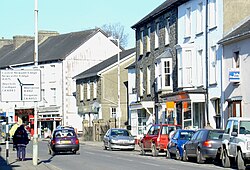Lampeter
| Lampeter Welsh: Llanbedr Pont Steffan | |
| Cardiganshire | |
|---|---|
 Lampeter | |
| Location | |
| Grid reference: | SN578478 |
| Location: | 52°7’13"N, 4°4’56"W |
| Data | |
| Population: | 1,989 |
| Post town: | Lampeter |
| Postcode: | SA48 |
| Dialling code: | 01570 |
| Local Government | |
| Council: | Ceredigion |
| Parliamentary constituency: |
Ceredigion |
Lampeter is a town in Cardiganshire, sitting where the River Teifi and the Afon Dulas meet.
At the 2001 National Census, the population was 2,894, making it the smallest university town in both Wales and the United Kingdom. The university in question is The University of Wales, Trinity Saint David, formerly the Lampeter campus of the University of Wales, and in a normal year it adds a further 1,000 people to the town's population and gives the rural town a somewhat cosmopolitan feel.
History
The Norman castle of Pont Steffan ("Stephen's Bridge") occupied a strategic position beside the River Teifi. It was destroyed in 1187 after it had been conquered by Owain of Gwynedd. The castle's remains later became the foundations for C R Cockerell's college building and still form part of the university campus.
Cardiganshire was one of the royal counties established by Edward I after the defeat of Llywelyn the Last (Llywelyn Ein Llyw Olaf) at Cilmeri in 1282, when Lampeter fell under direct Royal Control. This, however, had little effect on the town and the Welsh language and culture]] continued to thrive.
The first borough charter was granted in 1284 to Rhys ap Meredydd who was given the right to hold a weekly market. As many as eight fairs were also held each year under successive charters. One of these was the Dalis Horse fair.
The town was ruled by a local aristocracy who lived in elegant mansions including Brynhywel, Maesyfelin and Peterwell. As magistrates, these handed out the severest of penalties to offenders. The fairs and markets had become rowdy occasions characterised by violence and drunkenness and the stocks and whipping post in front of the town hall were frequently put to use in the 18th century.
The town developed the crafts, services and industries to cater for the needs of the rural area. There were several woollen mills, one of which in the mid-18th century was already producing the complex double-woven tapestry cloth later to become associated with the Welsh woollen industry. There were also blacksmiths, a leather tannery, carpenters, saddlers, bootmakers and hatters. The town was one of the main centres for the dispatch of cattle and sheep on foot to the markets of south east England. The large number of inns point to the town's importance as a rural centre and have names such as the Nag's Head, the Drovers and the Three Horseshoes.[1]
Lampeter's War Memorial was unveiled in September 1921. It was sculpted by Sir William Goscombe John.
University
The University of Wales, Trinity Saint David (formerly University of Wales, Lampeter) was founded in 1827 by Bishop Burgess of St David's to provide training for those wishing to join the Anglican priesthood. In 1852 it was granted a charter to award the BD degree and in 1865 another charter enabled it to confer BA degrees in liberal arts.[1] It was a constituent part of the University of Wales until 2008. Its central building, based on an Oxbridge quadrangle was designed by C R Cockerell.
The university's rugby team was Wales' first, having been formed in 1850 by Rowland Williams after he brought the game from Cambridge.
Culture
Lampeter and its surroundings are home to a theatre (Theatr Felin-fach at Felinfach), a museum.
Dylan Thomas' links with Lampeter and nearby Talsarn, where he lived, have been documented.[2] During the War, he and Caitlin lived at Plas Gelli, a secluded mansion just outside Talsarn. The Dylan Thomas Trail links Talsarn and Lampeter with the other places in Cardiganshire associated with the poet, such as Aberaeron and New Quay.
Lampeter hosted the National Eisteddfod in 1984.